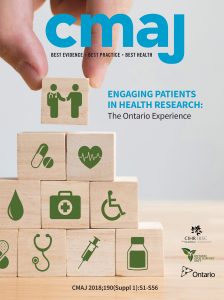Patient engagement in research can improve health and the health system
November 7/2018
Does engaging patients in research projects improve health? A comprehensive collection of 17 innovative Demonstration projects – from youth involvement in mental health services to suicide prevention, Indigenous health, children with complex medical needs and more – highlights the value of patient engagement in research.
 Engaging Patients in Health Research: the Ontario Experience, a special patient-oriented research supplement in the Canadian Medical Association Journal, features in-the-trenches experiences, tips and challenges from 17 IMPACT projects funded by the Ontario SPOR Support Unit (OSSU). It is a resource for researchers and others interested in this growing approach that involves patients and caregivers as partners in health and health systems research.
Engaging Patients in Health Research: the Ontario Experience, a special patient-oriented research supplement in the Canadian Medical Association Journal, features in-the-trenches experiences, tips and challenges from 17 IMPACT projects funded by the Ontario SPOR Support Unit (OSSU). It is a resource for researchers and others interested in this growing approach that involves patients and caregivers as partners in health and health systems research.
“The innovative, collaborative approach of these projects underscores Ontario’s role as a leader in putting patients first and in seeking ways to improve patient health and the way health care is delivered,” says Professor Adalsteinn Brown, Chair, OSSU’s Board of Directors and DLSPH Dean.
“We expect that OSSU’s IMPACT projects will live up to their name as they will impact the way we deliver health care, from emergency services to mental health, hip fracture care to heart failure care and more,” said Brown.
Lived experience of patients and caregivers can make health research more relevant to patient needs by focusing on patient-identified priorities which can improve health and the health system.
Examples:
- Youth-determined study outcomes – ability to function in daily life was the most important outcome in a study to help youth access mental health and addiction services, recommended by youth rather than researcher-identified symptom relief. (YouthCan IMPACT project)
- Novel recruitment – in a study looking at providing access to essential medicines, with the advice of patient partners, researchers hit the streets of Toronto wearing branded t-shirts to ensure diverse representation.
- Partnerships are key – a study looking at diabetes in First Nations people involved a close partnership with Chiefs of Ontario who co-developed the study with an Elder, First Nations patient navigators as well as researchers. (Diabetes in First Nations)
- Create a safe environment – people with lived experience helped design a smartphone app to help men seeking help after self-harm and at risk of suicide. A key lesson was “the need to create a safe environment where patients are able to share their personal experiences through the power of “testament”. Flexibility and support were also important to allow patient partners to withdraw or rejoin the project depending on their mental health. (Suicide prevention in men)
- Lived experience of older adults and caregivers – the transition from hospital to home can be difficult for older adults with multiple illnesses and symptoms of depression. Older adult patient partners and caregivers contributed insights into the unique challenges facing them and their caregivers in a support program to help ease the transition. “Patient/Caregiver Partners have also helped researchers and trainees to better understand issues older adults face with transitional care.” (Engaging older adults as partners in transitional care research)
In 2014, OSSU issued a call to fund translational research projects that aimed to conduct Innovative, Measurable, Patient-oriented, Appropriate, Collaborative and Transformative (IMPACT) research to improve patient health in Ontario. The complete list of 17 IMPACT projects in pediatrics, mental health, Indigenous health, chronic disease and health systems research is available here.
“Just as the patient experience in clinical care is important, so too is the patient perspective in research,” says Dr. Diane Kelsall, Editor-in-Chief (Acting), CMAJ. “Asking patients and families about what is important to them results in better research studies that address patient health priorities which can benefit the health system. CMAJ sees patient-oriented research as an important, emerging research area and we hope this supplement will be a resource for researchers.”
Funding bodies such as the National Institute for Health Research in the United Kingdom and the Patient-Centred Outcome Research Institute (PCORI) in the United States are supporting patient-oriented research, along with the Canadian Institutes for Health Research (CIHR). Journals are increasingly asking how patients were involved in the research. CMAJ Open, a sister journal to CMAJ, has launched a patient-oriented research section to attract and publish this type of research.
“Engaging patients as partners makes them active, rather than passive, participants whose experience and ideas can enrich research projects,” says Frank Gavin, Patient Partner and Chair, Citizen Engagement Council for the CHILD-BRIGHT SPOR Network. “We hope this publication will be a resource to anyone interested in conducting patient-oriented research.”
